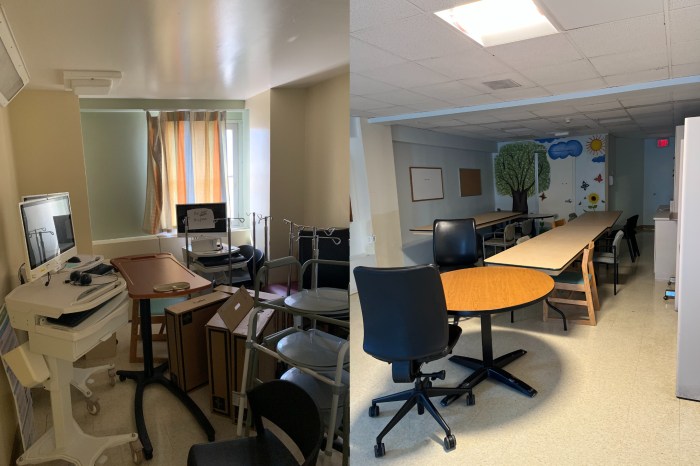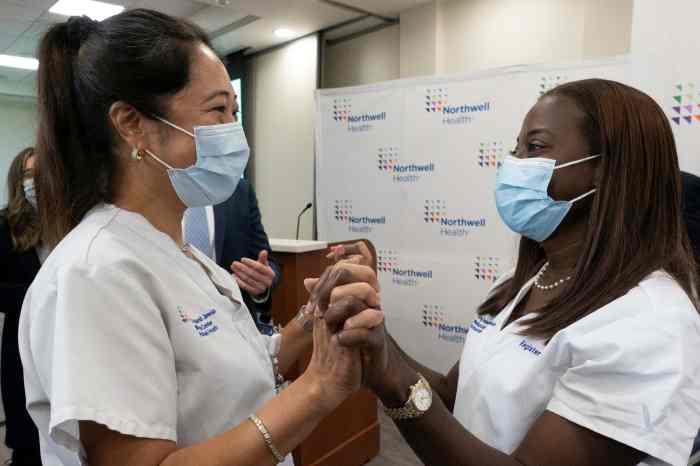Wendy Darwell is one of Long Island healthcare’s more important players, as president and CEO of the Suburban Hospital Alliance of New York State, the advocacy organization representing hospitals on Long Island and in the Hudson Valley. We talked with her about the state of the Long Island healthcare industry.
What do you think is the biggest challenge facing Long Island’s healthcare system today? It’s retaining and rebuilding the healthcare workforce. We have a workforce that is understandably exhausted from the last three incredible years under Covid. This is showing its strain across the healthcare system.
How is that strain being felt? Every hospital in the state reported that they are short on nurses and desperately trying to recruit them. Seventy-five % of hospitals reported shortages for other positions. On Long Island, we’ve had shortages in positions like nurses’ aides, laboratory techs, radiology techs, pharmacy. Covid has really been the tipping point.
Is it about pay, Covid concerns, aging, other reasons, or all of the above? At this moment, burnout is the number one issue. It’s been an incredibly challenging time. Hospitals have been overwhelmed by patients struggling to provide the best possible care for a new disease.
Is the healthcare workforce aging? We do have an aging workforce as well. We knew we would face a retirement cliff. Covid probably pushed that up a few years.
What can be and what is being done? We need to do different things in the short term and the long term. In the short term, we’ve been bringing in temporary staff, which is not optimal. The workforce is a zero-sum game. There is a finite number of doctors, nurses and other professionals. We’re all competing against each other for that pool of labor.
Where do we stand with Covid, the flu and respiratory syncytial virus (RSV)? We have seen an uptick in Covid cases on Long Island. A percentage of the population is susceptible to very severe Covid. Complicating factors such as chronic conditions, older age and obesity tend to result in worse outcomes for patients. People want to think the worst of the pandemic is over and the worst of it is, because we have vaccines and treatments. But people will still get very sick from Covid.
And the flu? The flu has hit early and hard in our region. And we have the RSV virus circulation, which primarily impacts children. That’s a lot more people in the hospital, adding more pressure, when we’re struggling with staffing and financially.
A fall 2022 survey by New York’s state and allied regional hospital associations found that 85% of hospitals report negative or unsustainable operating margins of less than 3%. What can be done? We need help from public payers on rates that they pay. Over the course of the last three years, Medicaid rates went up 1%. The Medicare increase over the past three years was 8.75% for inpatient rates.
How are hospitals handling inflation? That’s really the challenge. Back before Covid, we were dealing with reimbursement rates far below the cost of providing care. That’s only gotten worse with inflation. Medicaid on Long Island reimburses hospitals about 60% of the cost of care. Medicare is about 90%.
What is the most important thing to do? We need to see reimbursement rates increase. We’ve seen temporary or one-shot support for hospitals from the federal government in terms of pandemic relief. In the state budget last year there was money for one-shot investments.
What good things are going on? We have an incredibly resilient system. Our hospitals are staffed by extremely talented and dedicated professionals who have worked very hard to keep our community safe over the last few years. And we continue to innovate.
Have we learned and improved things amid Covid? There’s that expression, “Never waste a crisis.” The crisis we’ve been in since 2020 has resulted in innovations in care and the team who provide care. Many hospitals are using not just nurses at the bedside, but nurses’ aides and lab techs. Other professionals are working as a team to take care of patients. There are benefits from clinical professionals in multiple disciplines working as a team to take care of patients.
Is at-home testing becoming more important? The decision quickly by the federal government to invest in and authorize at-home Covid tests is a real milestone in the healthcare world. Very few at-home tests were approved in the past. Now I think the floodgates are open. We’re seeing more innovation in that area.
































